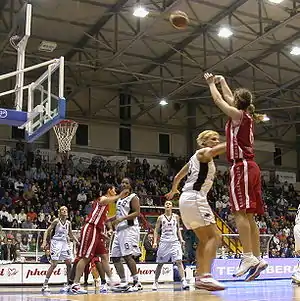籃球服
籃球服是籃球球員所穿的制服。 籃球服背面有球員的號碼和姓氏(或名字),通常還會搭配短褲和運動鞋。在隊伍中,球員會穿上代表球隊顏色的球衣。主場隊伍通常會穿淺色的球衣,客場隊伍通常會穿深色的球衣。

不同的籃球聯賽對於場上的球衣有不同的規範。在籃球早期發展階段中,球員可以穿著任何類型的運動服。但在20世紀初期,特殊的運動服已經被製造出來並販售給籃球員。球衣的風格、剪裁還有合身程度在後來的幾十年中不斷改進,而改進的方向大抵以當時的流行為主。
歷史
Jerseys and shorts


最早,籃球服裝並沒有被規範,而是有各式各樣的種類,從田徑服到美式足球服都有人穿著。The first official basketball uniforms, as displayed in the Spalding catalog of 1901, featured three types of pants: knee-length padded pants, similar to those worn for playing football, as well as shorter pants and knee-length tights. There were two types of suggested jersey, a quarter-length sleeve and a sleeveless version.[1]
The long pants later evolved into medium-length shorts in the 1920s, and by the 1930s, the material used for jerseys changed from heavy wool to the lighter polyester and nylon. In the 1970s and 80s, uniforms became tighter-fitting and shorts were shorter, consistent with the overall fashion trends of these two decades.[2] At this time, women's basketball uniforms transitioned from longer-sleeved uniforms to tank-top style jerseys similar to men's basketball uniforms, which more explicitly showed off players' muscle tone.[3]
In 1984, Michael Jordan asked for longer shorts and helped popularize the move away from tight, short shorts toward the longer, baggier shorts worn by basketball players today.[4][5] Throughout the 1990s, basketball uniforms fell under the influence of hip hop culture, with shorts becoming longer and looser-fitting, team colors brighter, and designs more flashy and suggestive of rappers' bling.[6] At the turn of the 21st century, basketball uniforms became even more oversized and loose-fitting; the arm holes in women's basketball jerseys remained smaller than men's, but were wide enough to reveal the players' sports bras.[3]
.jpg.webp)
Sleeved jersey
For the Christmas Day games of 2013, the NBA and its apparel partner Adidas introduced a newly designed sleeved jersey with large team and NBA logos on the front.[7] Marketers for the new uniforms realized that fans were unwilling to wear sleeveless jerseys in their day-to-day life and hoped the new sleeved jerseys would be more popular for everyday wear.[8] However, it was also a "not-so-well-kept secret that the NBA wanted to implement jersey ads in the years following the introduction of sleeved jerseys" as the "sleeves allow more space for potential partners to add their corporate logos to jerseys" like association football (soccer). After the league deal with Adidas expired and Nike signed on as the new apparel partner, the sleeved jersey did not continue.[9]
The sleeved jersey was controversial among players. LeBron James famously ripped the sleeves off during a prime time game against the New York Knicks in 2015, but in the 2016 NBA Finals James convinced his teammates to wear the sleeved jerseys in Game 5 and again in the title-clinching Game 7.[10][11][12][13][14][15]
Shoes
In 1903, a special basketball shoe with suction cups to prevent slippage was added to the official basketball uniform demonstrated in the Spalding catalog.[1] Over the decades, different shoe brands and styles were popular as basketball shoes: Chuck Taylor All-Stars and Keds in the 1960s and 70s; Adidas and Nike leather high-tops in the late 1970s and 80s; and Air Jordans in the 1990s.[4]
配飾
1970年代時,斯歷克·沃茨和標·禾頓開始佩戴頭巾,很快就受到其他球員的歡迎,歷克·巴利促使腕帶的流行,其他球員很快創造了變化,例如覆蓋前臂或二頭肌的腕帶,這些配飾可用作擦汗或簡單時尚之用。[4]
現代
規定
在職業籃球或正式比賽中,主場隊伍通常會穿著比客場隊伍更淺色的球衣。[16]
在NBA中,球褲褲緣不能超過膝蓋以上一英呎處,而且球衣底下不能穿著T-shirts;而美國大學籃球的規定就比較寬鬆。許多NBA與WNBA在球衣上有著贊助商的廣告標誌。[17]
材質
Uniforms are made of wicking material designed to absorb sweat and ensure that it evaporates faster.[2] They are the product of a four-year study researching professional basketball players, who identified the need for fewer seams, lighter weight, and faster drying and cooling in their jerseys.[5]
International basketball leagues
The main difference between U.S. basketball uniforms and those of other countries is the appearance of sponsorship iconography; European basketball uniforms are often covered in the logos of their sponsors (similar to association football), while the U.S. uniforms (like other major pro sports) feature the team wordmark/logo front and center.[18]
For the 2017-18 season, some U.S. teams have started putting sponsorship logos on their jerseys on the upper left of the jersey which is a maximum of 2.5 inches by 2.5 inches.[19]
參見
- Sportswear (activewear)
註釋
- James Naismith. . U of Nebraska Press. 1941: 89–90. ISBN 0-8032-8370-9.
- Lucia Raatma. . Capstone Press. 1 January 2012: 13. ISBN 978-1-4296-7537-6.
- Sarah McCullough. . ProQuest. 2007: 76–78. ISBN 978-0-549-26375-3.
- Nate LeBoutillier. . Capstone. 1 January 2011: 58–59. ISBN 978-1-4296-5468-5.
- Suzanne Slade. . Capstone. 1 January 2013: 20–21. ISBN 978-1-4296-9956-3.
- Jeffrey Lane. . U of Nebraska Press. 1 December 2007: 41. ISBN 0-8032-0755-7.
- Patt, Jason. . SBNation. [25 December 2013].
- Holmes, Elizabeth. . WSJ Online. [25 December 2013].
- . NBA.com/Cavaliers (NBA Media Ventures, LLC). October 21, 2015 [October 22, 2015]. (原始内容存档于2018-08-11).
- . SI.com. 19 June 2016 [2017-06-17].
- Vardon, Joe. . cleveland.com. 4 June 2017 [2017-06-17]. (原始内容存档于2017-06-08) (美国英语).
- . NBA.com/Cavaliers (NBA Media Ventures, LLC). May 31, 2017 [June 13, 2017].
- Boone, Kyle. . CBSSports.com. 1 June 2017 [2017-06-17] (英语).
- P. J. Harari; Dave Ominsky. . First Base Sports, Inc. 1 October 2002: 10. ISBN 978-1-884309-13-7.
- Sandomir, Richard. . The New York Times. 31 May 2009 [25 December 2013].
- O'Brien, Dan. . The Bleacher Report. [25 December 2013]. (原始内容存档于2016-03-05).
外部連結
Template:Supporter Culture
